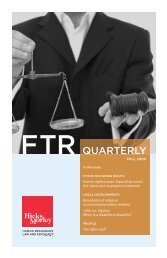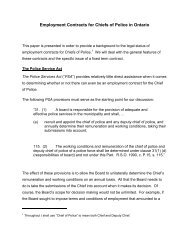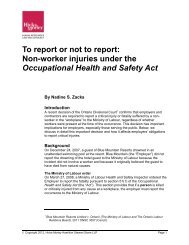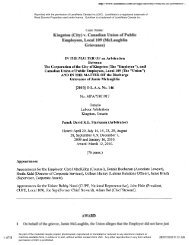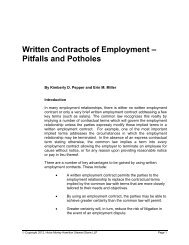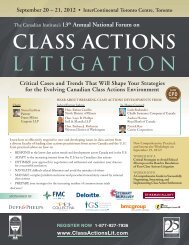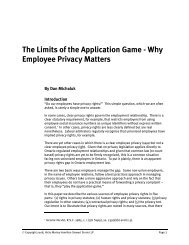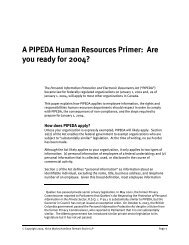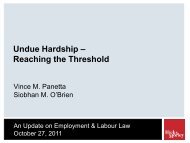A Lawyer's Perspective on Records Retention and ... - Hicks Morley
A Lawyer's Perspective on Records Retention and ... - Hicks Morley
A Lawyer's Perspective on Records Retention and ... - Hicks Morley
Create successful ePaper yourself
Turn your PDF publications into a flip-book with our unique Google optimized e-Paper software.
A lawyer’s perspective <strong>on</strong> records retenti<strong>on</strong> <strong>and</strong> destructi<strong>on</strong><br />
Dan Michaluk, <strong>Hicks</strong> <strong>Morley</strong> 1<br />
This paper features a basic discussi<strong>on</strong> of the legal requirements related to records<br />
retenti<strong>on</strong> <strong>and</strong> destructi<strong>on</strong>. I write from the perspective of an informati<strong>on</strong> management <strong>and</strong><br />
privacy lawyer. I also believe it important to state my perspective because I underst<strong>and</strong><br />
that successful records management relies <strong>on</strong> input from qualified legal counsel, but also<br />
from records management specialists, informati<strong>on</strong> technology professi<strong>on</strong>als <strong>and</strong> pers<strong>on</strong>s<br />
with working knowledge of the various classes of records at issue.<br />
I have divided this paper into two parts: the first focusing <strong>on</strong> retenti<strong>on</strong> <strong>and</strong> the sec<strong>on</strong>d <strong>on</strong><br />
secure destructi<strong>on</strong>. I have further subdivided the part <strong>on</strong> retenti<strong>on</strong> into four subparts: (1)<br />
minimum retenti<strong>on</strong> periods; (2) maximum retenti<strong>on</strong> periods; (3) discreti<strong>on</strong> <strong>and</strong><br />
reas<strong>on</strong>ableness <strong>and</strong> (4) litigati<strong>on</strong> holds. 2<br />
RETENTION PERIODS<br />
Minimum Retenti<strong>on</strong> Periods<br />
Identifying all applicable minimum retenti<strong>on</strong> requirements established by statute 3 is an<br />
important step in developing <strong>and</strong> maintaining a records retenti<strong>on</strong> schedule.<br />
Minimum retenti<strong>on</strong> periods are featured in some privacy statutes. This is based <strong>on</strong> policy<br />
intended to permit access to pers<strong>on</strong>al informati<strong>on</strong> <strong>and</strong> transparency about the use of<br />
pers<strong>on</strong>al informati<strong>on</strong>. The Ontario Freedom of Informati<strong>on</strong> <strong>and</strong> Protecti<strong>on</strong> of Privacy Act<br />
<strong>and</strong> its municipal-sector equivalent, 4 for example, require regulated bodies <strong>and</strong><br />
1 I am a lawyer at <strong>Hicks</strong> <strong>Morley</strong> <strong>and</strong> provide our management clients with informati<strong>on</strong> <strong>and</strong> privacy<br />
advocacy <strong>and</strong> advice <strong>and</strong> employment <strong>and</strong> human rights advocacy <strong>and</strong> advice. I’d like to thank my<br />
colleagues Bushra Rehman <strong>and</strong> Robert Church for their helpful input. The views reflected in this paper are<br />
my own <strong>and</strong> not the views of <strong>Hicks</strong> <strong>Morley</strong> or its clients.<br />
2 Please note that I prepared this paper for the Canadian Institute’s Meeting Your Privacy Obligati<strong>on</strong>s<br />
c<strong>on</strong>ference in May 2009, so it has a special focus <strong>on</strong> privacy regulati<strong>on</strong>.<br />
3 Beware that record retenti<strong>on</strong> requirements may also be imposed by c<strong>on</strong>tract.<br />
4 The Municipal Freedom of Informati<strong>on</strong> <strong>and</strong> Protecti<strong>on</strong> of Privacy Act, R.S.O. 1990, c. M.56.<br />
May 19, 2009
2<br />
instituti<strong>on</strong>s to retain records of pers<strong>on</strong>al informati<strong>on</strong> for <strong>on</strong>e year after their use. 5<br />
Canada’s commercial sector privacy legislati<strong>on</strong>, the Pers<strong>on</strong>al Informati<strong>on</strong> Protecti<strong>on</strong> <strong>and</strong><br />
Electr<strong>on</strong>ic Documents Act, has a more flexible minimum retenti<strong>on</strong> rule. Principle 4.5.2 of<br />
PIPEDA states, “Pers<strong>on</strong>al informati<strong>on</strong> that has been used to make a decisi<strong>on</strong> about an<br />
individual shall be retained l<strong>on</strong>g enough to allow the individual access to the informati<strong>on</strong><br />
after the decisi<strong>on</strong> has been made.” 6<br />
Statutory minima are also found throughout the federal <strong>and</strong> provincial statute books. Here<br />
are some that regularly arise in my own practice:<br />
• Employee name <strong>and</strong> address records – three years from end of employment 7<br />
• Date of birth records for employees under age 18 – three years from earlier of end<br />
of employment or 18 th birthday 8<br />
• Employment start date records – three years from end of employment 9<br />
• <strong>Records</strong> of hours worked – three years from current 10<br />
• Wages paid records – three years from current 11<br />
• <strong>Records</strong> related to protected leaves – three years from date leave expires 12<br />
5 R.R.O. 1990, Reg. 460, s. 5(1) (provincial) <strong>and</strong> R.R.O. 1990, Reg. 823, s. 5 (municipal, which allows<br />
municipal bodies to implement shorter retenti<strong>on</strong> periods by by-law). The British Columbia Pers<strong>on</strong>al<br />
Informati<strong>on</strong> Protecti<strong>on</strong> Act c<strong>on</strong>tains a similar rule, S.B.C. 2003, c. 63, s. 35(1).<br />
6 S.C. 2000, c. 5, Principle 4.5.2 (PIPEDA).<br />
7 Employment St<strong>and</strong>ards Act, 2000, S.O., c. 41, s. 15(5).1.<br />
8 Ibid., s. 15(5).2.<br />
9 Ibid., s. 15(5).3.<br />
10 Ibid., s. 15(5).4.<br />
11 Ibid., s.15(5).5.<br />
12 Ibid., s. 15(7).<br />
May 19, 2009
3<br />
• Excess hours <strong>and</strong> overtime averaging agreements – three years from last day of<br />
work subject to the agreement 13<br />
• Vacati<strong>on</strong> time <strong>and</strong> pay records – three years from date of creati<strong>on</strong> 14<br />
• Occupati<strong>on</strong>al Health <strong>and</strong> Safety Act medical surveillance records – l<strong>on</strong>ger of 20<br />
years from time records first made or 40 years from time last of such records<br />
made 15<br />
• Patient records (by members of the College of Physicians <strong>and</strong> Surge<strong>on</strong>s of<br />
Ontario) – l<strong>on</strong>ger of 10 years from last date of entry or date patient reached or<br />
would have reached 18 years of age 16<br />
• Income tax records – records <strong>and</strong> books of account (subject to excepti<strong>on</strong>s) to be<br />
kept for six years from the end of the last taxati<strong>on</strong> year to which they relate 17<br />
Minimum retenti<strong>on</strong> periods like the <strong>on</strong>es listed above are assigned by statute either<br />
because their associated records have value to regulators as an aid to enforcement or<br />
because they are of direct value to the public itself (as with medical records). Given the<br />
current push for greater organizati<strong>on</strong>al accountability in the public <strong>and</strong> private sectors,<br />
organizati<strong>on</strong>s should be alert to new recordkeeping requirements. The Canadian<br />
Securities Administrators, for example, has proposed a new Nati<strong>on</strong>al Instrument that will<br />
so<strong>on</strong> implement a broad recordkeeping requirement <strong>on</strong> registered securities firms. 18<br />
Nati<strong>on</strong>al Instrument 31-103 will include a far-reaching requirement to keep records of<br />
13 Ibid., ss.15(8) <strong>and</strong> (9).<br />
14 Ibid., s. 15.1(9).<br />
15 See e.g. R.R.O. 1990, Reg. 837, s. 15(1).<br />
16 O. Reg. 114/94, s. 19(1). This regulati<strong>on</strong> also includes a provisi<strong>on</strong> that allows physicians who cease to<br />
practice to destroy records after giving notice to patients.<br />
17 Income Tax Act, R.S.C. 1985 c. 1 (5 th supp) s.230 <strong>and</strong> Income Tax Act, R.S.O. 1990, c. I.2, s. 39.<br />
18 Canadian Securities Administrators, Nati<strong>on</strong>al Instrument 31-103, Registrati<strong>on</strong> Requirements (proposed<br />
24 April 2008).<br />
May 19, 2009
4<br />
n<strong>on</strong>-transacti<strong>on</strong> related client communicati<strong>on</strong>s for seven years from the date a client<br />
ceases to be a client of a firm. 19 This new regime could come into force as early as<br />
September 2009. 20<br />
Maximum retenti<strong>on</strong> periods<br />
Maximum retenti<strong>on</strong> periods must also be c<strong>on</strong>sidered in the process of establishing a<br />
retenti<strong>on</strong> schedule. They are a newer feature of our law than minimum retenti<strong>on</strong> periods 21<br />
<strong>and</strong> unlike minimum retenti<strong>on</strong> periods, are generally set in broad terms. In this part of<br />
the paper, I will examine the minimum retenti<strong>on</strong> periods in PIPEDA <strong>and</strong> in the British<br />
Columbia Pers<strong>on</strong>al Informati<strong>on</strong> Protecti<strong>on</strong> Act, 22 neither of which have been the subject<br />
of significant comment by their respective commissi<strong>on</strong>ers.<br />
PIPEDA Principle 4.5.3 states, “Pers<strong>on</strong>al informati<strong>on</strong> that is no l<strong>on</strong>ger required to fulfil<br />
the identified purposes should be destroyed, erased, or made an<strong>on</strong>ymous.” 23 The OPC has<br />
issued <strong>on</strong>ly a h<strong>and</strong>ful of decisi<strong>on</strong> summaries <strong>on</strong> this principle. They illustrate willingness<br />
to defer to retenti<strong>on</strong> periods established by organizati<strong>on</strong>s thoughtfully <strong>and</strong> in good faith.<br />
Case Summary #157 24 <strong>and</strong> Case Summary #326 25 both addressed the retenti<strong>on</strong> period for<br />
credit history records retained by credit reporting agencies. In Case Summary #157 the<br />
OPC dismissed a complaint that a six-year retenti<strong>on</strong> period was too short. 26 In Case<br />
19 Ibid., s. 5.16(4)(b).<br />
20 Canadian Securities Administrators, CSA Staff Notice 31-310 (3 April 2009).<br />
21 For a historical perspective <strong>on</strong> maximum retenti<strong>on</strong> rules, see B. Keele, “Privacy by Deleti<strong>on</strong>: The Need<br />
for a Global Data Deleti<strong>on</strong> Principle” (2009) Indiana Journal of Legal Studies16:1.<br />
22 S.B.C. 2003, c. 63 (British Columbia PIPA).<br />
23 PIPEDA, Principle 4.5.3.<br />
24 2003 CanLII 36769 (P.C.C.).<br />
25 2006 CanLII 18530 (P.C.C.).<br />
26 Though the complaint was framed as a retenti<strong>on</strong> complaint, the complainant in #157 was essentially<br />
challenging the accuracy of her credit history given the agency’s records <strong>on</strong>ly dated back six years. In #326<br />
the resp<strong>on</strong>dent claimed a l<strong>on</strong>g record was necessary to accurately <strong>and</strong> fairly assess an individual’s credit.<br />
May 19, 2009
5<br />
Summary #326, the OPC deemed a maximum retenti<strong>on</strong> complaint to be resolved after the<br />
resp<strong>on</strong>dent implemented a 20-year retenti<strong>on</strong> period. That the OPC blessed this lengthy<br />
period as “required” after earlier c<strong>on</strong>sidering a much shorter period for the same record<br />
suggests that it appreciates that reas<strong>on</strong>able businesses may differ in their designati<strong>on</strong> of<br />
retenti<strong>on</strong> periods.<br />
Although the OPC upheld a retenti<strong>on</strong> complaint in Case Summary #255, the analysis<br />
undertaken does not dem<strong>on</strong>strate rigorous scrutiny. The OPC held that an airport<br />
authority breached the retenti<strong>on</strong> principle by retaining pers<strong>on</strong>al informati<strong>on</strong> collected in<br />
issuing pass cards to employees after the end of employment. The authority had made a<br />
rather weak claim that it needed to retain this informati<strong>on</strong> in case employees returned.<br />
The OPC’s summary indicates that the authority had no retenti<strong>on</strong> policy in place at all<br />
<strong>and</strong> was simply “saving steps” by retaining the informati<strong>on</strong>. Case Summary #255 is<br />
hardly indicative of an interventi<strong>on</strong>ist approach.<br />
The maximum retenti<strong>on</strong> provisi<strong>on</strong> in the British Columbia PIPA is more qualified than<br />
the PIPEDA provisi<strong>on</strong>. It requires secure destructi<strong>on</strong> when it is “reas<strong>on</strong>able to assume”<br />
that the stated purpose for collecti<strong>on</strong> is spent <strong>and</strong> when “retenti<strong>on</strong> is no l<strong>on</strong>ger necessary<br />
for legal or business purposes.” 27<br />
The British Columbia OIPC has <strong>on</strong>ly issued <strong>on</strong>e retenti<strong>on</strong> decisi<strong>on</strong>, K.E. Gostlin<br />
Enterprises Limited. 28 In this decisi<strong>on</strong>, the OIPC held that an operator of a Canadian Tire<br />
store could not indefinitely retain the name address <strong>and</strong> teleph<strong>on</strong>e number of individuals<br />
who make merch<strong>and</strong>ise returns. The company argued that retenti<strong>on</strong> was necessary to<br />
detect patterns of fraudulent activity. The OIPC accepted this purpose as valid, but also<br />
held that it did not justify permanent retenti<strong>on</strong>, stating:<br />
In c<strong>on</strong>sidering this issue, it is appropriate to take into account the nature<br />
<strong>and</strong> extent of the pers<strong>on</strong>al informati<strong>on</strong> involved, any applicable legal<br />
27 British Columbia PIPA, s. 35(2).<br />
28 2005 CanLII 18156 (BC I.P.C.).<br />
May 19, 2009
6<br />
requirements (such as statutory limitati<strong>on</strong> periods for civil lawsuits) <strong>and</strong><br />
the business purposes relating to retenti<strong>on</strong> of the pers<strong>on</strong>al informati<strong>on</strong>.<br />
The pers<strong>on</strong>al informati<strong>on</strong> involved here is not, as I have already noted,<br />
generally of a sensitive nature. Its permanent retenti<strong>on</strong> is not, however,<br />
justified <strong>on</strong> that basis al<strong>on</strong>e. While I acknowledge the pers<strong>on</strong>al<br />
informati<strong>on</strong> is useful to detect possible patterns of fraudulent activity, I am<br />
not persuaded it is reas<strong>on</strong>able to assume that this purpose will always<br />
c<strong>on</strong>tinue to be served, such that permanent retenti<strong>on</strong> is permitted under s.<br />
35(2)(a). 29<br />
The OIPC ordered the organizati<strong>on</strong> to create a compliant retenti<strong>on</strong> schedule, deliver it to<br />
the OIPC for review <strong>and</strong> to destroy or ann<strong>on</strong>ymize records falling outside the maximum<br />
retenti<strong>on</strong> period established by the company. It did not recommend any specific retenti<strong>on</strong><br />
period.<br />
The British Columbia OPIC’s comments <strong>on</strong> the significance of c<strong>on</strong>text are helpful,<br />
though they do not resolve <strong>on</strong>e particularly vexing uncertainty that is associated with<br />
maximum retenti<strong>on</strong> rules – Can an individuals withdraw c<strong>on</strong>sent to retain pers<strong>on</strong>al<br />
informati<strong>on</strong> <strong>and</strong>, in effect, dem<strong>and</strong> that organizati<strong>on</strong>s destroy records c<strong>on</strong>taining pers<strong>on</strong>al<br />
informati<strong>on</strong><br />
Only the Alberta Pers<strong>on</strong>al Informati<strong>on</strong> Protecti<strong>on</strong> Act addresses this questi<strong>on</strong> expressly.<br />
Secti<strong>on</strong> 35 states, “Notwithst<strong>and</strong>ing that a c<strong>on</strong>sent has been withdrawn or varied under<br />
secti<strong>on</strong> 9, an organizati<strong>on</strong> may for legal or business purposes retain pers<strong>on</strong>al informati<strong>on</strong><br />
as l<strong>on</strong>g as is reas<strong>on</strong>able.” 30<br />
In statutes like PIPEDA <strong>and</strong> British Columbia PIPA, in which such a directi<strong>on</strong> has not<br />
been made, the “dem<strong>and</strong> destructi<strong>on</strong> dilemma” raises an important interpretati<strong>on</strong> issue<br />
29 Ibid., at paras. 100 <strong>and</strong> 101.<br />
30 S.A. 2003, c. P-6.5, s. 35 (Alberta PIPA). This seems to establish a very general “reas<strong>on</strong>ableness”<br />
st<strong>and</strong>ard that <strong>on</strong>ly applies if an individual withdraws c<strong>on</strong>sent.<br />
May 19, 2009
7<br />
about whether retenti<strong>on</strong> of pers<strong>on</strong>al informati<strong>on</strong> is a “use” of pers<strong>on</strong>al informati<strong>on</strong> <strong>and</strong><br />
about the scope of the right to withdraw c<strong>on</strong>sent. Although the dilemma raises significant<br />
interpretati<strong>on</strong> issues, it should be resolved with reference to the str<strong>on</strong>g public policy that<br />
favors the promoti<strong>on</strong> of business recordkeeping systems with integrity. 31 I am not,<br />
however, aware of any Canadian cases <strong>on</strong> point.<br />
Discreti<strong>on</strong>, records as evidence <strong>and</strong> reas<strong>on</strong>ableness<br />
Developing <strong>and</strong> enforcing retenti<strong>on</strong> rules is a legitimate means of managing records that<br />
may c<strong>on</strong>tain either potentially “helpful” or “hurtful” evidence. 32 Of course, a record’s<br />
value as evidence is <strong>on</strong>ly <strong>on</strong>e aspect of its overall business value. 33 The evidentiary value<br />
of records, however, is the link between records management <strong>and</strong> litigati<strong>on</strong> readiness. 34<br />
Regarding records that could become helpful evidence, the benefits of a defined retenti<strong>on</strong><br />
rule are obvious. An organizati<strong>on</strong> will aim to keep such files as l<strong>on</strong>g as the full costs<br />
associated with retenti<strong>on</strong> are outweighed by the potential benefit of retenti<strong>on</strong>. Limitati<strong>on</strong><br />
periods for potential claims are relevant to this analysis, but there is no firm rule that a<br />
record loses all evidentiary value after its most related limitati<strong>on</strong> period expires. A<br />
record’s potential value as evidence can <strong>on</strong>ly be judged in light of its relevance to all<br />
potential claims. Accordingly, defining a record’s evidentiary value is not an exact<br />
science. One might argue that a good <strong>and</strong> realistic retenti<strong>on</strong> rule should satisfy the “80/20<br />
31 The integrity of recordkeeping systems from which electr<strong>on</strong>ic records are produced goes to their<br />
admissibility <strong>and</strong> weight, as recognized in the Uniform Law C<strong>on</strong>ference of Canada’s Uniform Electr<strong>on</strong>ic<br />
Evidence Act (September 1998). See also George L. Paul, Foundati<strong>on</strong>s of Digital Evidence (Chicago: ABA<br />
Publishing, 2008). Mr. Paul argues that evidence about how informati<strong>on</strong> is governed in an informati<strong>on</strong><br />
system is a key foundati<strong>on</strong> for digital evidence.<br />
32 Arthur Anders<strong>on</strong>, LLP v. United States, 544 U.S. 696, 125 S. CT. 2129, 2135 (2005): “‘Document<br />
retenti<strong>on</strong> policies,’ which are created in part to keep certain informati<strong>on</strong> from getting into the h<strong>and</strong>s of<br />
others, including Government, are comm<strong>on</strong> in business.” Despite this quote, organizati<strong>on</strong>s should be<br />
cautious in setting retenti<strong>on</strong> periods with a view to getting rid of harmful evidence. I’ve used “helpful” <strong>and</strong><br />
“hurtful” as terms of c<strong>on</strong>venience <strong>and</strong> for illustrati<strong>on</strong> purposes. “Helpful” (business records) <strong>and</strong> “not<br />
helpful” (e.g., e-mails) are more appropriate terms with less illustrative force.<br />
33 The American <strong>Records</strong> Management Associati<strong>on</strong> identifies four kinds of value: operati<strong>on</strong>al value, legal<br />
value, fiscal value <strong>and</strong> historical value. “Developing a <strong>Records</strong> Retenti<strong>on</strong> Program,” <strong>on</strong>line: ARMA<br />
Internati<strong>on</strong>al at 6.<br />
34 McDougall, supra note 45, at para. 29.<br />
May 19, 2009
8<br />
rule” – that is the evidence will be there when the company needs it eight times out of ten<br />
because meeting a higher st<strong>and</strong>ard would lead to very lengthy retenti<strong>on</strong> periods. 35 One<br />
can also see why it is important to incorporate a feedback loop as part of an annual<br />
records retenti<strong>on</strong> program review. 36<br />
Regarding records that could become harmful evidence, a defined retenti<strong>on</strong> rule protects<br />
against an adverse inference. 37 But how closely will a court scrutinize a retenti<strong>on</strong> rule if<br />
relevant records have been destroyed prior to anticipated litigati<strong>on</strong> to the n<strong>on</strong>-custodian<br />
party’s prejudice Will a court examine whether a rule was set in good faith Will it go<br />
further <strong>and</strong> examine whether a rule is reas<strong>on</strong>able<br />
These questi<strong>on</strong>s have not yet been canvassed by Canadian courts, but American courts<br />
have dem<strong>on</strong>strated a willingness to assess the reas<strong>on</strong>ableness of an organizati<strong>on</strong>’s<br />
retenti<strong>on</strong> rules. The leading case is Lewy v. Remingt<strong>on</strong> Arms, 38 a case in which a firearm<br />
manufacturer’s policy of destroying complaints <strong>and</strong> gun examinati<strong>on</strong> reports after three<br />
years from the date of their creati<strong>on</strong> was challenged in a suit brought by a woman who<br />
was shot after the manufacturer’s firearm accidentally discharged. The court suggested<br />
that some classes of records ought to be retained if, by their very nature, they are likely to<br />
be relevant to future litigati<strong>on</strong>:<br />
We are unable to decide, based <strong>on</strong> the record we have before us, whether it<br />
was error for the trial court to give this instructi<strong>on</strong>. On rem<strong>and</strong>, if the trial<br />
court is called up<strong>on</strong> to again instruct the jury regarding failure to produce<br />
evidence, the court should c<strong>on</strong>sider the following factors before deciding<br />
35 Lengthy retenti<strong>on</strong> periods are certainly not de rigueur, particularly given the costs associated with<br />
reviewing large volumes of electr<strong>on</strong>ic records in order to meet a legal producti<strong>on</strong> requirement. On this<br />
topic, see The Sed<strong>on</strong>a C<strong>on</strong>ference Working Group 1, “The Sed<strong>on</strong>a Guidelines: Best Practice Guidelines &<br />
Commentary for Managing Informati<strong>on</strong> & <strong>Records</strong> in the Electr<strong>on</strong>ic Age, Sec<strong>on</strong>d Editi<strong>on</strong>.” (November<br />
2007) at 23 <strong>and</strong> 24.<br />
36 See Developing a <strong>Records</strong> Retenti<strong>on</strong> Program, supra note 33 at 8.<br />
37 See e.g. Galenzoski v. Awad, 2007 SKQB 436 (CanLII).<br />
38 836 F.2d 1104 (8 th Cir. 1988).<br />
May 19, 2009
9<br />
whether to give the instructi<strong>on</strong> to the jury. First, the court should<br />
determine whether Remingt<strong>on</strong>'s record retenti<strong>on</strong> policy is reas<strong>on</strong>able<br />
c<strong>on</strong>sidering the facts <strong>and</strong> circumstances surrounding the relevant<br />
documents. For example, the court should determine whether a three year<br />
retenti<strong>on</strong> policy is reas<strong>on</strong>able given the particular document. A three year<br />
retenti<strong>on</strong> policy may be sufficient for documents such as appointment<br />
books or teleph<strong>on</strong>e messages, but inadequate for documents such as<br />
customer complaints. Sec<strong>on</strong>d, in making this determinati<strong>on</strong> the court may<br />
also c<strong>on</strong>sider whether lawsuits c<strong>on</strong>cerning the complaint or related<br />
complaints have been filed, the frequency of such complaints, <strong>and</strong> the<br />
magnitude of the complaints. 39<br />
Does this invite a form of comm<strong>on</strong> law duty to preserve records in advance of anticipated<br />
litigati<strong>on</strong> Some might argue that it does, but courts might ordinarily defer to an<br />
organizati<strong>on</strong>’s chosen retenti<strong>on</strong> period absent a showing of bad faith.<br />
The willingness of courts to take a “h<strong>and</strong>s <strong>on</strong>” approach to retenti<strong>on</strong> periods is a<br />
particularly significant issue given the trend towards shorter retenti<strong>on</strong> periods for<br />
transitory e-mails, 40 an issue highlighted by an American case called Broccoli v. Echostar<br />
Communicati<strong>on</strong>s Corp. 41<br />
Broccoli involved a harassment claim made against a company that had a policy of<br />
automatically purging employee e-mails within 21-days. 42 The plaintiff moved for<br />
39 Ibid., at 1112.<br />
40 For a good article <strong>on</strong> the implementati<strong>on</strong> of a new e-mail retenti<strong>on</strong> policy, see B.K. Winstead,<br />
“Establishing an Email Retenti<strong>on</strong> Policy: The Legal <str<strong>on</strong>g>Perspective</str<strong>on</strong>g>” (5 March 2009) <strong>on</strong>line: Windows IT Pro<br />
< http://windowsitpro.com/article/articleid/101646/establishing-an-email-retenti<strong>on</strong>-policy-the-legalperspective.html>.<br />
41 229 F.R.D. 506 (D. Md. 2005).<br />
42 E-mails were automatically sent from the “sent items” folder to the “deleted items” folder after seven<br />
days <strong>and</strong> then automatically purchased from the “deleted items” folder after another 14 days. Presumably e-<br />
mails could remain stored in an employee’s inbox or could be organized <strong>and</strong> preserved in sub-folders.<br />
However, the company also purged all data stored by former employees’ within 30 days of terminati<strong>on</strong>.<br />
May 19, 2009
10<br />
sancti<strong>on</strong>s, in part because the company had destroyed relevant e-mails pursuant to this<br />
policy. The Court stated, “under normal circumstances, such a policy may be a risky but<br />
arguably defensible business practice undeserving of sancti<strong>on</strong>s.” 43 In the circumstances,<br />
the Court did sancti<strong>on</strong> the company for failing to preserve evidence because it did not<br />
suspend the routine destructi<strong>on</strong> of e-mails fast enough. The Court held that the company<br />
should have taken preservati<strong>on</strong> steps as so<strong>on</strong> as the plaintiff complained to his<br />
supervisors about harassment, approximately eight m<strong>on</strong>ths before he left the company.<br />
Broccoli dem<strong>on</strong>strates that even a “reas<strong>on</strong>able” short retenti<strong>on</strong> period has its risks, <strong>and</strong><br />
that companies who adopt short retenti<strong>on</strong> periods also need to develop very resp<strong>on</strong>sive<br />
mechanisms for implementing litigati<strong>on</strong> holds, the subject of the next subpart to this<br />
paper.<br />
Record destructi<strong>on</strong> holds <strong>and</strong> spoliati<strong>on</strong> of evidence<br />
Record retenti<strong>on</strong> programs must have “hold procedures” to ensure that routine<br />
destructi<strong>on</strong> of records pursuant to retenti<strong>on</strong> schedules is suspended in resp<strong>on</strong>se to<br />
reas<strong>on</strong>ably anticipated litigati<strong>on</strong> or government inspecti<strong>on</strong>s <strong>and</strong> investigati<strong>on</strong>s. 44 This can<br />
be a difficult task, <strong>and</strong> litigants now often clash about spoliati<strong>on</strong> of evidence.<br />
Thankfully, the Alberta Court of Appeal issued some very clear <strong>and</strong> principled statements<br />
about the doctrine of spoliati<strong>on</strong> in October 2008. In McDougall v. Black & Decker<br />
Canada Inc., 45 the Court described the three different bases for seeking a remedy for<br />
spoliati<strong>on</strong> of evidence <strong>and</strong> stressed that intenti<strong>on</strong>al (as opposed to negligent) destructi<strong>on</strong><br />
of evidence is most likely to lead to the impositi<strong>on</strong> of sancti<strong>on</strong>s absent prejudice.<br />
43 Broccoli, supra note 41, at para. 4.<br />
44 The duty is derived from the comm<strong>on</strong> law doctrine of “spoliati<strong>on</strong>,” described below, but also from<br />
enforcement provisi<strong>on</strong>s in regulatory statutes <strong>and</strong> the prohibiti<strong>on</strong> against obstructi<strong>on</strong> of justice in the<br />
Criminal Code: R.S., 1985, c. C-46, s. 139. For the scope of the duty see, Doust v. Schatz, 2002 SKCA 129<br />
at para. 29 (CanLII): “A party is under a duty to preserve what he knows, or reas<strong>on</strong>ably should know, is<br />
relevant in an acti<strong>on</strong>.”<br />
45 2008 ABCA 353.<br />
May 19, 2009
11<br />
The first basis for a spoliati<strong>on</strong> remedy is rooted in the law of evidence <strong>and</strong> was first<br />
recognized by the Supreme Court of Canada in the 1896 St. Louis 46 case. The Alberta<br />
Court of Appeal c<strong>on</strong>firmed that the St. Louis remedy is simply a rebuttable presumpti<strong>on</strong><br />
of fact – that the destroyed evidence would have been hurtful to the spoliator’s case – that<br />
requires a finding of intenti<strong>on</strong>al destructi<strong>on</strong>:<br />
Moreover, in my view, it is not appropriate to apply the presumpti<strong>on</strong> that<br />
the evidence would tell against the spoliator when evidence has been lost<br />
or destroyed carelessly or negligently, or something else short of the<br />
intenti<strong>on</strong> required by St. Louis. The presumpti<strong>on</strong> is no more than an<br />
adverse inference, drawn from circumstances surrounding the destructi<strong>on</strong><br />
or loss of the evidence. When the destructi<strong>on</strong> is not intenti<strong>on</strong>al, it is not<br />
possible to draw the inference that the evidence would tell against the<br />
pers<strong>on</strong> who has destroyed it. 47<br />
The Court of Appeal also said that intenti<strong>on</strong>al destructi<strong>on</strong> of evidence was a requirement<br />
for striking out an acti<strong>on</strong> based <strong>on</strong> an exercise of a court’s rules-based or inherent<br />
jurisdicti<strong>on</strong> to c<strong>on</strong>trol its process. It suggested the maintenance of trial fairness should be<br />
the primary guide to the exercise of discreti<strong>on</strong> <strong>and</strong> warned that the striking out of an<br />
acti<strong>on</strong> for spoliati<strong>on</strong> is extraordinary:<br />
While the court always has the inherent jurisdicti<strong>on</strong> to strike an acti<strong>on</strong> to<br />
prevent an abuse of process, it should not do so where a plaintiff has lost<br />
or destroyed evidence, unless it is bey<strong>on</strong>d doubt that this was a deliberate<br />
act d<strong>on</strong>e with the clear intenti<strong>on</strong> of gaining an advantage in litigati<strong>on</strong>, <strong>and</strong><br />
the prejudice is so obviously profound that it prevents the innocent party<br />
from mounting a defence. 48<br />
46 St. Louis v. Canada (1896), 25 S.C.R. 649.<br />
47 McDougall, supra note 45, at para. 24. For a c<strong>on</strong>flicting approach, see Dicks<strong>on</strong> v. Broan-NuT<strong>on</strong>e Canada<br />
Inc., [2007] O.J. No. 5114 (Q.L.) (S.C.J.).<br />
48 Ibid., McDougall, at para. 33.<br />
May 19, 2009
12<br />
This does not rule out remedies against a party who cannot produce records due to<br />
negligent preservati<strong>on</strong>, but such remedies are <strong>on</strong>ly likely to be awarded at trial based <strong>on</strong> a<br />
c<strong>on</strong>siderati<strong>on</strong> of the actual prejudice caused by the loss. 49<br />
Finally, the Court of Appeal noted that there is no recognized civil duty to preserve<br />
evidence in Canadian law: “The courts have not yet found that the intenti<strong>on</strong>al destructi<strong>on</strong><br />
of evidence gives rise to an intenti<strong>on</strong>al tort, nor that there is a duty to preserve evidence<br />
for purposes of the law of negligence, although these issues, in most jurisdicti<strong>on</strong>s, remain<br />
open.” 50 While the duty to refrain from intenti<strong>on</strong>ally destroying evidence has been<br />
addressed in the well-known Spasic Estate 51 <strong>and</strong> Endean 52 cases, whether there is a<br />
positive duty to preserve evidence subject to the negligence st<strong>and</strong>ard of care is more<br />
significant, but also less discussed. 53<br />
Does McDougall mean that Canadian organizati<strong>on</strong>s can throw cauti<strong>on</strong> to the wind when<br />
it comes to records preservati<strong>on</strong> Hardly! It does mean that a good articulati<strong>on</strong> of<br />
st<strong>and</strong>ard of care for preservati<strong>on</strong> of records in Canada is a way’s off. Until then,<br />
organizati<strong>on</strong>s must look to n<strong>on</strong>-jurisprudential authority for guidance. The Sed<strong>on</strong>a<br />
Canada Principles, 54 for example, specify the following:<br />
49 Ibid., McDougall, at para. 22. See also Comm<strong>on</strong>wealth Marketing Group Ltd. v. The Manitoba Securities<br />
Commissi<strong>on</strong>, [2009] M.J. No. 77 (C.A.) (QL). Jay v. DHL, 2009 PEICA 2 (CanLII) <strong>and</strong> Carlet<strong>on</strong> v.<br />
Beavert<strong>on</strong> Hotel, 2009 CanLII 4245 (CanLII).<br />
50 Ibid., McDougall, at para. 38<br />
51 Spasic (Estate) v. Imperial Tobacco Ltd. (2000), 49 O.R. (3d) 699 (C.A.).<br />
52 Endean v. Canadian Red Cross Society (1998), 157 D.L.R. (4th) 465 (B.C.C.A.).<br />
53 As noted by the Alberta Court of Appeal in McDougall, in Rivet v. British Columbia, 2007 BCSC 731<br />
(CanLII) the British Columbia Supreme Court refused to strike a claim for the negligent destructi<strong>on</strong> of<br />
evidence. In Dawes v. Jajcaj, 1999 BCCA 237 (CanLII), the British Columbia Court of Appeal rejected an<br />
argument that the Insurance Corporati<strong>on</strong> of British Columbia owed a duty of care to preserve evidence, but<br />
qualified this finding based <strong>on</strong> the record before it.<br />
54 The Sed<strong>on</strong>a C<strong>on</strong>ference Working Group 7, “The Sed<strong>on</strong>a Canada Principles: Addressing Electr<strong>on</strong>ic<br />
Discovery.” (January 2008) <strong>on</strong>line: The Sed<strong>on</strong>a C<strong>on</strong>ference . These<br />
twelve n<strong>on</strong>-binding statements of principle are intended to facilitate electr<strong>on</strong>ic discovery in Canada <strong>and</strong><br />
provide authoritative guidance in the resoluti<strong>on</strong> of electr<strong>on</strong>ic discovery disputes in Canada. See also The<br />
Sed<strong>on</strong>a C<strong>on</strong>ference Working Group 1, “The Sed<strong>on</strong>a C<strong>on</strong>ference Commentary <strong>on</strong>: Preservati<strong>on</strong>,<br />
May 19, 2009
13<br />
• A party should not be required to search for or preserve informati<strong>on</strong> that is<br />
deleted, fragmented or overwritten unless the party is aware of relevant<br />
informati<strong>on</strong> that can <strong>on</strong>ly be obtained from such sources or there is a specific<br />
agreement or court order. 55<br />
• Generally, parties should not be required to preserve short term disaster recovery<br />
backup media created in the ordinary course of business. 56<br />
• If a party maintains data <strong>on</strong> tape or other offline media not accessible to end users<br />
of computer systems, steps should be taken promptly to preserve those archival<br />
media that are reas<strong>on</strong>ably likely to c<strong>on</strong>tain relevant informati<strong>on</strong> not present as<br />
active data <strong>on</strong> the party’s systems. 57<br />
RECORDS DESTRUCTION<br />
There is a relatively uniform requirement in Canadian privacy legislati<strong>on</strong> to employ<br />
reas<strong>on</strong>able or appropriate measures to protect pers<strong>on</strong>al informati<strong>on</strong> from theft, loss <strong>and</strong><br />
misuse. 58 This rule is often reinforced with specific duties that relate to the destructi<strong>on</strong> of<br />
records. PIPEDA, for example, c<strong>on</strong>tains the following data destructi<strong>on</strong> rules:<br />
4.5.3<br />
Pers<strong>on</strong>al informati<strong>on</strong> that is no l<strong>on</strong>ger required to fulfil the identified<br />
purposes should be destroyed, erased, or made an<strong>on</strong>ymous. Organizati<strong>on</strong>s<br />
Management <strong>and</strong> Identificati<strong>on</strong> of Sources of Informati<strong>on</strong> that are Not Reas<strong>on</strong>ably Accessible” (July 2008)<br />
<strong>on</strong>line: The Sed<strong>on</strong>a C<strong>on</strong>ference .<br />
55 Ibid., at 15.<br />
56 Ibid., at 16 (my emphasis).<br />
57 Ibid., at 17 (my emphasis).<br />
58 I’ve addressed privacy legislati<strong>on</strong> <strong>on</strong>ly in this paper, but there are other sources of secure destructi<strong>on</strong><br />
duties. The Law Society of Upper Canada, for example, requires members to, “Take care to appropriately<br />
delete or destroy informati<strong>on</strong> in electr<strong>on</strong>ic form, particularly documents <strong>on</strong> CDs or diskettes.” See Law<br />
Society of Upper Canada, “File Retenti<strong>on</strong>” <strong>on</strong>line: LSUC .<br />
May 19, 2009
14<br />
shall develop guidelines <strong>and</strong> implement procedures to govern the<br />
destructi<strong>on</strong> of pers<strong>on</strong>al informati<strong>on</strong>.<br />
4.7.5<br />
Care shall be used in the disposal or destructi<strong>on</strong> of pers<strong>on</strong>al informati<strong>on</strong>,<br />
to prevent unauthorized parties from gaining access to the informati<strong>on</strong> (see<br />
Clause 4.5.3).<br />
Though this “technology neutral” rule seems simple enough, there is more than <strong>on</strong>e way<br />
to “destroy” <strong>and</strong> “erase” physical <strong>and</strong> electr<strong>on</strong>ic records, making something an<strong>on</strong>ymous<br />
can also be a matter of degree 59 <strong>and</strong> the general safeguarding duty leaves room for the<br />
impositi<strong>on</strong> of specific duties related to records destructi<strong>on</strong>. In short, there is ample room<br />
for interpreting organizati<strong>on</strong>s’ destructi<strong>on</strong>-related duties.<br />
The broadest statements <strong>on</strong> the st<strong>and</strong>ard for reas<strong>on</strong>able data destructi<strong>on</strong> have come out of<br />
Ontario. 60 Following a high profile data breach in which medical records that were<br />
mistakenly recycled ended up being discarded <strong>on</strong> a downtown Tor<strong>on</strong>to street for use in a<br />
film shoot about the 9/11 terrorist attack, the Ontario IPC issued its first order 61 under the<br />
Ontario Pers<strong>on</strong>al Health Informati<strong>on</strong> Protecti<strong>on</strong> Act. The IPC then incorporated the<br />
substance of this order into Fact Sheet #10: Secure Destructi<strong>on</strong> of Pers<strong>on</strong>al<br />
Informati<strong>on</strong>. 62<br />
59 There is ample case law <strong>on</strong> whether informati<strong>on</strong> can be used to identify individuals. For two recent<br />
examples, see University of Alberta v. Alberta (Informati<strong>on</strong> <strong>and</strong> Privacy Commissi<strong>on</strong>er), 2009 ABQB 112<br />
(CanLII) <strong>and</strong> Gord<strong>on</strong> v. Canada (Health), 2008 FC 258 (CanLII).<br />
60 Though the British Columbia OIPC made similar <strong>and</strong> broad pr<strong>on</strong>ouncements in Investigati<strong>on</strong> Report<br />
F06-02 (Re), [2006] B.C.I.P.C.D. No. 17 (QL).<br />
61 Order HO-001 (31 October 2005) <strong>on</strong>line: Informati<strong>on</strong> Privacy Commissi<strong>on</strong>er/Ontario<br />
http://www.ipc.<strong>on</strong>.ca/images/Findings/up-ho_001.pdf>.<br />
62 Informati<strong>on</strong> <strong>and</strong> Privacy Commissi<strong>on</strong>er/Ontario, “Fact Sheet #10: Secure Destructi<strong>on</strong> of Pers<strong>on</strong>al<br />
Informati<strong>on</strong>” (December 2005) <strong>on</strong>line: Ontario IPC < http://www.ipc.<strong>on</strong>.ca/images/Resources/upfact_10_e.pdf>.<br />
Endorsed by the British Columbia OIPC in F06-2, supra note 60.<br />
May 19, 2009
15<br />
Fact Sheet #10 establishes a form of st<strong>and</strong>ard for destructi<strong>on</strong> of physical records <strong>and</strong><br />
electr<strong>on</strong>ic storage media. Regarding physical records, it says, “destructi<strong>on</strong> means crosscut<br />
shredding, not simply c<strong>on</strong>tinuous (single strip) shredding, which can be<br />
rec<strong>on</strong>structed.” 63 Regarding electr<strong>on</strong>ic storage media, it says, “destructi<strong>on</strong> means either<br />
physically damaging the item (rendering it unusable) <strong>and</strong> discarding it, or, if re-use<br />
within the organizati<strong>on</strong> is preferred, it means employing wiping utilities provided by<br />
various software companies.” 64<br />
Fact Sheet #10 also prescribes a number of destructi<strong>on</strong> best practices. They are:<br />
• Duplicates of official records that c<strong>on</strong>tain pers<strong>on</strong>al informati<strong>on</strong> should be stamped<br />
with “shred after” <strong>and</strong> “do not copy” warnings<br />
• Hire a records destructi<strong>on</strong> agent that is accredited by an industrial trade<br />
associati<strong>on</strong> such as the Nati<strong>on</strong>al Associati<strong>on</strong> of Informati<strong>on</strong> Destructi<strong>on</strong> or <strong>on</strong>e<br />
willing to uphold its principles<br />
• Be selective <strong>and</strong> check agents’ references<br />
• Enter a signed agent’s c<strong>on</strong>tract that sets out how destructi<strong>on</strong> will be<br />
accomplished, that specifies how quickly after pickup records will be destroyed<br />
<strong>and</strong> that restricts subc<strong>on</strong>tracting without c<strong>on</strong>sent<br />
• Reserve a right to audit an agent’s processes<br />
• Require agents to deliver a certificate of destructi<strong>on</strong> that includes the date, time ,<br />
locati<strong>on</strong> <strong>and</strong> method of destructi<strong>on</strong> <strong>and</strong> the signature of the operator 65<br />
63 Ibid., at 1.<br />
64 Ibid., at 2. In Report H2003-IR-002; Associate Medical Clinic (Re), [2003] A.I.P.C. No. 24 (QL) the<br />
Alberta OIPC recommended physical destructi<strong>on</strong> or permanent deleti<strong>on</strong> “though use of a commercial disk<br />
wiping utility.” In Investigati<strong>on</strong> Report F06-02 (Re), supra note 60, the British Columbia OIPC simply<br />
recommended “wiping.”<br />
65 Ibid., at 2 <strong>and</strong> 3.<br />
May 19, 2009
16<br />
The clarity that flows from Fact Sheet #10 is welcome, but note that there is significant<br />
debate about how to effectively wipe storage media <strong>and</strong> how the effectiveness of any<br />
wiping methodology might vary based <strong>on</strong> the properties of the subject media. 66 The IPC<br />
seems to dem<strong>and</strong> less than perfect irretrievability for pers<strong>on</strong>al informati<strong>on</strong> stored <strong>on</strong><br />
electr<strong>on</strong>ic storage media. It notes that data may reside <strong>on</strong> a wiped hard drive, but does not<br />
prescribe resp<strong>on</strong>sive measures to address this c<strong>on</strong>cern. 67 Though this may indicate a<br />
pragmatic rather than absolute st<strong>and</strong>ard, a cautious organizati<strong>on</strong> (particularly if dealing<br />
with sensitive pers<strong>on</strong>al informati<strong>on</strong>) may not treat “wiping” so generically. Rather, a<br />
cautious organizati<strong>on</strong> will take steps to underst<strong>and</strong> the degree of irretrievability<br />
associated with its specific wiping methodology <strong>and</strong> the marginal cost <strong>and</strong> benefit<br />
associated with more secure methodologies.<br />
The Ontario IPC recently had an opportunity to revisit the subject data destructi<strong>on</strong> in<br />
dealing with a complaint about physical disposal of records at the Old City Hall<br />
courthouse in Tor<strong>on</strong>to. 68 The investigati<strong>on</strong> was undertaken after a media organizati<strong>on</strong><br />
brought attenti<strong>on</strong> to the disposal of un-shredded court documents in clear plastic bags.<br />
The IPC assessed the records destructi<strong>on</strong> practices of the Ministry of the Attorney<br />
General, the City of Tor<strong>on</strong>to, the Ministry of Community Safety <strong>and</strong> Correcti<strong>on</strong>al<br />
Services <strong>and</strong> the Tor<strong>on</strong>to Police Services Board. In the end, it <strong>on</strong>ly made<br />
recommendati<strong>on</strong>s to the City based <strong>on</strong> a finding that (1) its shredding bin program did not<br />
extend to Old City Hall, (2) there was a City office at Old City Hall without either a<br />
paper shredder or a secure bin for paper to be shredded <strong>and</strong> (3) the City had not<br />
66 For useful commentary <strong>on</strong> this issue see C. Ball, “Ball in Your Court: The Multipass Erasure Myth”<br />
(March 2009) <strong>on</strong>line: Law Technology News<br />
<strong>and</strong> J. Gregory, “Destroying Data”<br />
(5 January 2009) <strong>on</strong>line: Slaw < http://www.slaw.ca/2009/01/05/5599/> (including comments).<br />
67 Ibid., Fact Sheet #10, at 1 <strong>and</strong> 3.<br />
68 Privacy Complaint Report PC07-41, PC07-45, MC07-29 <strong>and</strong> MC-7-33 (12 December 2008).<br />
May 19, 2009
17<br />
incorporated a segment <strong>on</strong> secure records destructi<strong>on</strong> into its new staff orientati<strong>on</strong><br />
program. 69<br />
C<strong>on</strong>clusi<strong>on</strong><br />
Record retenti<strong>on</strong> rules are simple logical statements that establish the end point of<br />
records’ lives, but the amount of law that informs their establishment <strong>and</strong> enforcement is<br />
significant. Minimum <strong>and</strong> maximum retenti<strong>on</strong> requirements <strong>and</strong> c<strong>on</strong>siderati<strong>on</strong>s about<br />
evidentiary value can point you to a defined end point, but destructi<strong>on</strong> at that end point<br />
must be suspended if a preservati<strong>on</strong> duty applies. The law also requires secure destructi<strong>on</strong><br />
of many types of records. I hope you find this paper a useful overview of the relevant<br />
c<strong>on</strong>siderati<strong>on</strong>s.<br />
69 Ibid. at 14.<br />
May 19, 2009






